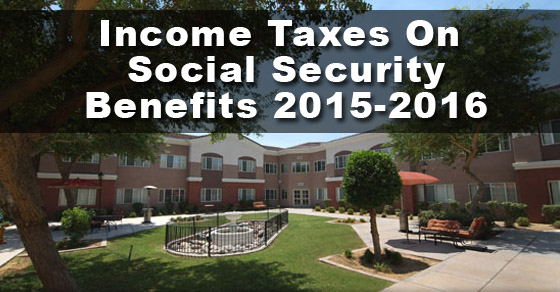How Much Taxes Will I Pay On Social Security Benefits 2016

*This information is compiled from a Disability and Retirement Report created by a Social Security Office about Social Security Income Taxation. Chaparral Winds Retirement Community is not a tax professional-consult with your tax preparer or other professional before making decisions based upon this issue.
First of all, if you are a retiree who lives in Arizona you are in luck. Arizonian’s don’t have to pay taxes on Social Security Benefits.
Many of our retirees who receive Social Security Benefits either:
- Don’t know they have to pay taxes on Social Security Benefits or, they do know they have to pay taxes on Benefits from Social Security, but
- Not sure how much taxes they need to pay on their Social Security Benefits
This post is all about how much taxes you will need to pay on your Social Security Benefits in 2015-2016.
Depending on the how much Social Security benefits you receive will gauge the amount of taxes you will pay on them. Since 1984, Beneficiaries above certain income thresholds are required to claim only “part” of their benefits when filing taxes. These income thresholds have not changed since they were first established by Congress. Although, wages have increased and the amount of beneficiaries who have to pay income tax on benefits has risen. Back in 1984, only 10% of people receiving benefits had to pay income taxes on their Social Security Benefits. In 2015-2016 tax season, you can go ahead and raise that number up and multiply it by 5. More than 52% of beneficiaries will have to pay taxes on their benefits in 2015-206, according to the Micro-simulation Model presented by the SSA(Social Security Administration).
12 States That Tax Social Security Benefits
- Montana
- North Dakota
- Minnesota
- Missouri
- Kansas
- Nebraska
- New Mexico
- Colorado
- Utah
- West Virginia
- Connecticut
- Vermont
For 2015-2016, family beneficiaries will only owe 1% or less taxes on their benefits, however, 1/4 of these families will owe 11% or higher taxes on their Social Security benefits.
The Micro-simulation model also projected that taxes on benefits will rise to 5%. And, The 52% of families in the 2015 model will surely rise to 12% by the year 2050.
How much federal taxes do you have to pay on your Social Security Benefits?
The way they calculate the taxable income is quite difficult to explain. The link below provides an easy chart from the Social Security report that explains how they calculate taxable Social Security Income.
Here is a quick overview of the tax on Social Security Benefits formula:
Take a look at the Benefits Planner.pdf on SSA.Gov. Here’s a quick break down of their formula below.
*Single Filer Benefits Formula:
Single Filer: Below $25,000 (AGI) Modified Adjusted Gross Income, pay no tax
Single Filer: Between $25,000 – $34,000 pays 50% taxes on benefit income or AGI above 25k.
Single Filer: Above $34,000 pays 85% taxes on Social Security benefits
*Married Jointly Filing Benefits Formula:
Married Jointly Filing: Below $32,000 (AGI) Modified Adjusted Gross Income, pay no tax
Married Jointly Filing: Between $32,000 – $44,000 pays 50% taxes on benefit income or AGI above 32k.
Married Jointly Filing: Above $44,000 pays 85% taxes on Social Security benefits
Estimating Taxes paid on Social Security Benefits Once You’re Retired
If you or your tax preparer can estimate your modified Adjusted Gross Income for when you are retired, you will be able to estimate how much taxes you have to pay on your Social Security benefits.
Definition of Adjusted Gross Income:
“Adjusted gross income (AGI) is an individual’s total gross income minus specific deductions” – Wikipedia.
To be able to come up with a realistic estimate you will also have to know how much Social Security benefits you will be receiving. To figure that out, jump over to the Social Security Administration’s Benefit Estimator. If you can’t figure it out, ask your tax preparer to help estimate it for you.
Conclusion:
If you live on Social Security benefits alone, you may not have to pay taxes on your benefits as long as you are either, in a state that doesn’t make you pay taxes on benefits, single filer whose income is less than $25,000 or if your are married filing jointly with income less than $32,000.
Leave a comment below: Many retirees think Congress needs to modify the taxation thresholds on benefits. Some believe that taxation progression is ok and should happen. What are your thoughts? Do you pay federal income taxes on Social Security benefits? Are you surprised that beneficiaries have to pay so much taxes on their income? Please leave a comment below.
Chaparral Winds Offers The Finest Retirement Living In Surprise, Arizona
Chaparral Winds is a retirement facility in Surprise, Arizona offering assisted living, independent living, and memory care services. For more information about our senior living facility, SLS Communities or to schedule a tour, please call us today at 623-343-4125.

